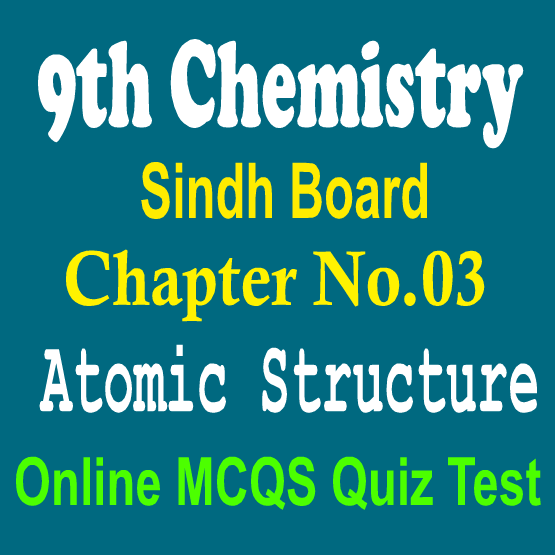9th Grade Chemistry Chapter 3 Atomic Structure Sindh Board MCQs Notes Online Chapter Wise Question Answers. Sindh Boards Chemistry Subject Notes For Exams Preparations Karachi, Jamshoro, Sindh Boards. Chemistry class Ninth sindh board notes Unit 3 Atomic Structure Most Repeated Multiple Choice Questions With Answers. Chemistry notes for class IX sindh board karachi Boards.
 |
| 9th MCQs Atomic Structure Unit 3 chemistry |
Q.1: The nucleus of an atom consists of:?
- Electrons and neutrons
- Electrons and protons
- Protons and neutrons
- None of these
C
Q.2: Which particle is the lightest in the following:?
- particles
- Electron
- Proton
- Neutron
B
Q.3: Which particles is heavier than others.?
- particles
- Proton
- Neutron
- Electron
C
Q.4: The mass of electron is:?
- 9.11 x 10-28g
- 9.11 x 10-27g
- 9.11 x 10-30g
- 9.11 x 10-26g
A
Q.5: The mass of proton is:?
- 1.67 x 10-25g
- 1.67 x 10-24g
- 1.67 x 10-23g
- 1.67 x 10-22g
B
Q.6: Charge on an electron is:?
- 1.6 x 10-19g
- 1.6 x 10-17g
- 1.6 x 10-18g
- 1.6 x 10-16g
A
Q.7: Atoms are neither created n or destroyed in chemical reaction is the assumption of?
- Dalton
- Rutherford
- Bohrs
- Democritus
A
Q.8: Electrons were discovered by?
- Rutherford
- J.J Thomson
- James Chadwick
- Goldstein
B
Q.9: James Chadwick discovered the?
- Nucleus
- Neutron
- Proton
- Electron
B
Q.10: Which rays deflected towards negative pole in electric or magnetic field.?
- Alpha rays
- Cathode rays
- Beta rays
- Gamma rays
A
Q.11: The e/m ratio of the ---------- rays varies with the nature of gas in the discharged tube.?
- Positive rays
- Cathode rays
- Gamma rays
- Beta rays
A
Q.12: In Rutherford’s experiment very few alpha particles are?
- Deflected at large angles
- un deflected
- bounced
- none of these
C
Q.13: Atomic number of oxygen is?
- 9
- 8
- 7
- 6
B
Q.14: Tritium and isotopes of hydrogen contains ---------- neutrons.?
- 3
- 1
- 2
- none
C
Q.15: Chemical properties of an element depend on the ---------- in the shells.?
- Protons
- neutrons
- electrons
- none of them
C
Q.16: Mass number of protium is:?
- 2
- 1
- 4
- 3
B
Q.17: When cathode rays hit an object, they produce?
- Sound
- Darkness
- Effervescence
- Fluorescence
D
Q.18: A neutron has a mass equal to a proton and it has?
- No charge
- Negative charge
- Double positive charge
- Positive charge
A
Q.19: A proton is how many times heavier than an electron?
- 1936
- 1736
- 1636
- 1836
D
Q.20: Radioactive rays are of?
- 3 types
- 6 types
- 4 types
- 2 types
A
Q.21: Who put forward his atomic model in 1911?
- Rutherford
- Goldstein
- Neil Bohr
- Aufbau
A
Q.22: The mass of an atom is concentrated in the?
- Orbit
- Shell
- Nucleus
- Energy level
C
Q.23: Atomic number shows the number of electrons or protons in an atom and is denoted by?
- Z
- M
- A
- N
A
Q.24: The maximum number of electron in a shall is found out by the formula?
- 2n2
- n
- n2
- 2n
A
Q.25: Which particle is the lightest in the following?
- Particles
- Proton
- Electron
- Neutron
C
Q.26: Which particles is heavier than others?
- Particles
- Proton
- Neutron
- Electron
C






